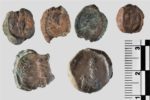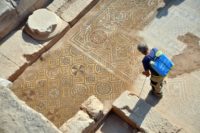 The ancient site of Doliche near modern-day Dülük in southern Turkey has done it again. An international team of archaeologists led by Dr. Engelbert Winter of the University of Münster has unearthed more than 1,000 bullae or clay seal impressions from Doliche’s municipal archive.
The ancient site of Doliche near modern-day Dülük in southern Turkey has done it again. An international team of archaeologists led by Dr. Engelbert Winter of the University of Münster has unearthed more than 1,000 bullae or clay seal impressions from Doliche’s municipal archive.
Doliche was renown throughout the Greek and Roman world for its shrine to Jupiter. Jupiter Dolichenus was a syncretic iteration, a composite of the original Hittite sky/storm god Tesub-Hadad with the Greco-Roman god of lightning Zeus/Jupiter, but the mystery religion spread widely after the Romans conquered the city in 64 B.C. and had adherents all over the empire, including the most desirable adherents a sanctuary might want, i.e., emperors.
Dr. Winter and his team discovered evidence found more than 600 seals in the excavation of 2013. They were votive offerings made to the temple long before the Roman conquest — between the 7th and 4th centuries B.C.) which gave historians a rare chance to study the religious culture and imagery of the ancient city before the deity was absorbed into the Greco-Roman pantheon. The cache discovered this season is later in date (2nd-3rd centuries A.D.) and many pieces of it appear to be official administrative seals from the city archives. Their large size, their discovery in the city rather than the temple precinct and some inscriptions attest to their origin.
Engelbert Winter on the significance of this major distinction:
“The fact that administrative authorities sealed hundreds of documents with the images of gods shows how strongly religious beliefs shaped everyday life.”
“The cult of Jupiter Dolichenus did not only take place in the nearby central temple, but also left its mark on urban life,” he said.
“It also becomes apparent how strongly Jupiter Dolichenus, originally worshipped at this location, was connected with the entire Roman Empire in the 2nd and 3rd centuries CE: many of the images show the god shaking hands with various Roman emperors.”
The gods depicted on the seals are also rife with political and civic meaning.
“In addition to the images of the ‘city goddess’ Tyche, the depictions of Augustus and Dea Roma deserve special attention, since they point to the important role of the Roman emperor and the personified goddess of the Roman state for the town of Doliche, which lies on the eastern border of the Roman Empire,” Professor Winter said.
“However, the central motif is the most important god of the city, Jupiter Dolichenus. In the 2nd and 3rd centuries CE, his cult spread into large parts of the Mediterranean world, extending as far as Britain.”
“Therefore, it is not surprising that hundreds of documents were sealed with images showing a handshake between this deity and an emperor. It was a sign of the god’s affinity to the Roman state.”
 Doliche’s deep bench produced other exceptional finds this year. Archaeologists discovered a brilliantly colored ancient mosaic floor underneath a later ancient floor in a three-aisled building complex. The mosaic is believed to date to around 400 A.D., and Winter thinks it is from a Christian church built there in late antiquity. Winter’s team has been excavating the church since 2015 and 150 square meters (1615 square feet) of the nave have been revealed this year.
Doliche’s deep bench produced other exceptional finds this year. Archaeologists discovered a brilliantly colored ancient mosaic floor underneath a later ancient floor in a three-aisled building complex. The mosaic is believed to date to around 400 A.D., and Winter thinks it is from a Christian church built there in late antiquity. Winter’s team has been excavating the church since 2015 and 150 square meters (1615 square feet) of the nave have been revealed this year.
But wait, there’s more!
The researchers also found the public center of the town of Doliche, which they had initially located by geophysical prospecting in the east of the city. “This assumption has been confirmed,” said the excavation leader. “We were able to expose parts of a very large building:
it is a well-preserved mosaic baths of the Roman Empire. As there are hardly any Roman thermal springs in the region, this discovery is of great scientific importance. “The research team from Münster also brought new insights into the extent of the city area and the chronology of the city: A year on the settlement hill of the ancient city, The Keber Tepe, carried out intensive survey led to quite surprising results: “A variety of Stone Age finds indicate that Keber Tepe was evidently a very significant place from a very early age. Doliche then reached its greatest extent in the Roman and early Byzantine period.”
These kind of fantastically layered, information-rich finds are why Winter, his co-workers and sponsors have been going back to the site every year since 2001.